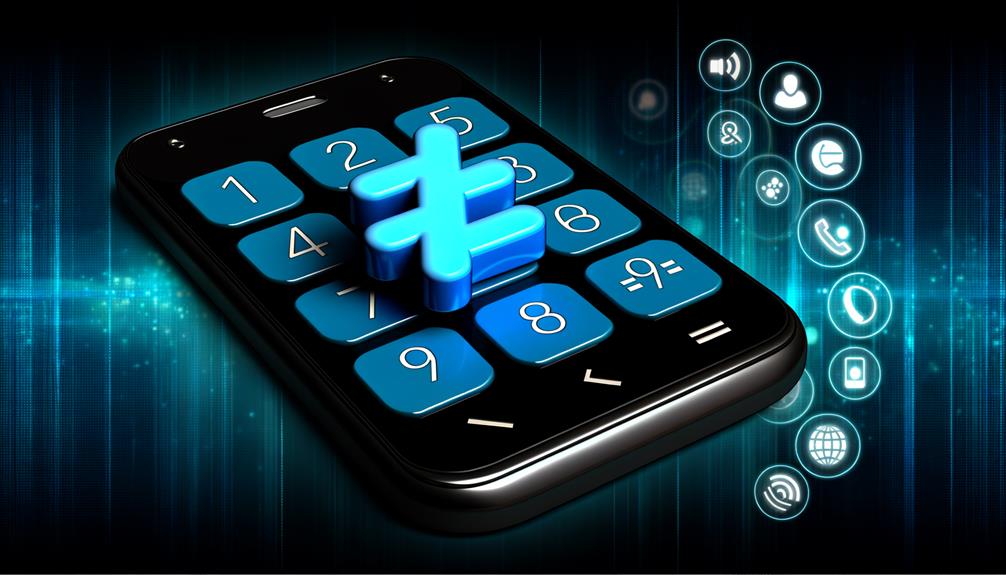Pound Symbol Use on a Phone?
The pound symbol on a phone, also known as the hash key (#), serves as a critical delimiter in telecommunications. It terminates commands, facilitates navigation in automated systems, and activates essential telephony features like accessing voicemail and confirming input in IVR menus.
The symbol is fundamental for users to efficiently manage voicemail settings, initiate specific commands, and configure phone preferences. Its role extends to international calls and emergency services, improving call routing and response times.
Understanding its functions and applications can greatly enhance user experience in phone operations and automated systems. Stay tuned for in-depth insights.

Key Takeaways
- The pound symbol (#) acts as a delimiter in telephony services for confirming commands and inputs.
- It terminates sequences in voicemail systems, activating various telephony services.
- Known as the 'hash key' in many phone operations, it facilitates menu navigation and feature activation.
- In text messaging, it serves as a special character and is used for categorizing content with hashtags.
- It finalizes dialing sequences in international calls and accesses emergency services efficiently.
History of the Pound Symbol

The pound symbol (#), also known as the number sign or hash, has a multifaceted history that dates back to the 14th century when it was used as an abbreviation for the Latin term 'libra pondo,' meaning pound weight.
Over time, the symbol evolved, becoming widely adopted in various contexts including mathematics, where it denotes a number, and computing, where it serves as a key in programming languages like Python.
In telecommunications, it gained prominence with the advent of touch-tone telephones in the 1960s, facilitating automated systems and user commands.
This historical trajectory underscores its versatility and enduring relevance, as it seamlessly integrates into modern technological applications while retaining its foundational significance.
Pound Symbol Vs Hash Key
Confusion often arises between the pound symbol (#) and hash key due to their interchangeable usage in different technological and cultural contexts. Technologically, both terms can refer to the same character but their applications vary considerably.
Telecommunication systems often use the term 'pound' whereas computing environments and social media platforms prefer 'hash.' Understanding the nuances is essential for clarity:
- Telecommunications: Used to terminate commands or initiate special functions.
- Computing: Identifies preprocessor directives in programming languages like C and C++.
- Social Media: Denotes hashtags to categorize and search content.
- International Variations: Known as 'octothorpe' in some regions, leading to further confusion.
This distinction matters for precision in technical fields and effective cross-platform communication.
Basic Functions on Phones

Understanding the role of the pound symbol is foundational to grasping the basic functions on phones, which encompass a myriad of essential operations such as dialing, accessing voicemail, and activating special features.
The pound symbol, often referred to as the 'hash key,' serves as a delimiter in various telephony services. For instance, when entering a phone number followed by the pound symbol, it signals the system to process the input.
In voicemail systems, it often concludes a sequence to access messages or settings. Additionally, the pound symbol is employed to activate supplementary services like call forwarding or conference calls.
This multifunctional key is integral to maneuvering modern telecommunication systems efficiently, ensuring seamless user interaction.
Role in Automated Systems
The pound symbol (#) plays a critical role in automated systems by enabling efficient navigation through interactive voice response (IVR) menus. It often functions as a delimiter to confirm input selections, ensuring the system accurately processes user commands.
This enhances user experience by facilitating seamless interaction with automated services.
Navigating Phone Menus
In automated phone systems, the pound symbol (#) plays a crucial role in moving through menus, confirming selections, and completing actions. Its integration into telephony navigational interfaces optimizes user interaction by enabling efficient command execution.
Key functions include:
- Menu Navigation: Skipping to the main menu or returning to previous options.
- Action Confirmation: Finalizing entries, such as account numbers or PINs.
- Command Execution: Initiating specific procedures or triggering automated responses.
- Session Termination: Ending a call or exiting a specific menu.
These utilities streamline user experiences, minimize errors, and enhance system responsiveness. By leveraging the pound symbol, automated systems guarantee seamless interaction, vital for user satisfaction and operational efficiency.
This design is pivotal in modern telephony, supporting robust user interface frameworks.
Confirming Input Selections
Confirming input selections using the pound symbol (#) is a critical function in automated systems, ensuring accurate data entry and smooth operational flow.
In interactive voice response (IVR) systems, the pound key serves to signal the completion of user input, prompting the system to process the entered data. This functionality is pivotal in scenarios such as banking transactions, customer support, and telecommunication services, where precision and efficiency are paramount.
By demarcating the end of an input sequence, the pound symbol helps mitigate errors and enhances user experience. Additionally, it enables systems to differentiate between ongoing input and final confirmation, thereby facilitating reliable and effective automated responses.
This simple yet powerful tool is indispensable in modern telephony.
Special Features Access

Accessing special features on a phone often requires the use of the pound symbol (#) to initiate or conclude specific commands. This symbol serves as a critical input for various network and device functionalities.
Employing the pound symbol enables users to access hidden menus, toggle settings, and perform diagnostic checks.
- USSD Codes: Facilitate direct interaction with the service provider's server to check balance, data usage, etc.
- IMEI Display: Typing `*#06#` reveals the phone's unique International Mobile Equipment Identity.
- Call Forwarding: Activating or deactivating call forwarding settings involves sequences ending with #.
- Voicemail Access: Often requires entering a personalized PIN followed by the pound symbol to confirm.
Understanding these functions enhances user control and optimizes device performance.
Use in Text Messaging
Utilized for various functionalities within text messaging, the pound symbol (#) often serves as a delimiter or a special character in SMS protocols and social media hashtags. In SMS, it can demarcate segments of text, aiding in parsing commands or metadata.
Within social media platforms, hashtags (e.g., #trending) categorize content, enabling efficient search and discovery. This symbol's adoption into text messaging has extended its utility, allowing users to tag, track, and group conversations seamlessly.
Its integration into SMS-based applications enables features such as automated responses and service commands. The pound symbol's versatility in text messaging underscores its critical role in modern digital communication, enhancing both user experience and data organization.
Importance in Voicemail

In the context of voicemail systems, the pound symbol (#) plays an essential role.
It is commonly used to access voicemail settings and to signal the end of a voicemail recording, ensuring efficient navigation and message management.
These functionalities underscore the symbol's significance in maintaining streamlined communication protocols.
Access Voicemail Settings
Configuring voicemail settings is important for ensuring that important messages are received and managed efficiently. Accessing these settings typically involves using the pound symbol (#) on your phone.
By pressing # during various stages of voicemail interaction, users can conveniently navigate and modify their voicemail preferences.
Key functionalities include:
- Password Setup: Enhance security by setting up a unique voicemail password.
- Greeting Customization: Personalize your voicemail greeting to reflect your identity or professional tone.
- Mailbox Management: Review, save, or delete messages to maintain mailbox organization.
- Notification Settings: Configure alert preferences to be promptly informed of new messages.
Understanding how to effectively use the pound symbol (#) when accessing voicemail settings is important for best communication management.
End Voicemail Recording
Ending voicemail recording with the pound symbol (#) is crucial for guaranteeing that messages are accurately captured and properly stored. The pound symbol acts as a termination signal, indicating the end of the message recording process. This helps voicemail systems to delineate message boundaries and initiate storage protocols effectively. Consequently, it prevents cutoff errors and guarantees complete message delivery.
| Function | Description |
|---|---|
| Termination Signal | Ends the voicemail recording process |
| Message Boundary | Defines where the message stops |
| Storage Initiation | Triggers the storage of the message |
| Error Prevention | Ensures messages are not cut off |
Using the pound symbol is a standard practice across telephony systems, providing users with a reliable method to complete their voicemail recordings efficiently. This technical protocol enhances the robustness of voicemail services.
Pound Symbol in International Calls
When making international calls, the pound symbol (#) often serves as a critical delimiter for signaling the end of an input sequence, guaranteeing accurate dialing and connection. This functionality is essential for various telecommunication systems and protocols. The pound symbol helps in:
- Finalizing Dialing Sequences: Confirms the end of a phone number or code entry.
- Accessing International Services: Facilitates entry into global networks by marking completion of the dialing process.
- Avoiding Misinterpretation: Prevents additional digits from being appended, reducing dialing errors.
- Automated Systems Compatibility: Guarantees correct interaction with automated telephony systems by indicating the end of user input.
Emergency Services and the Pound Key

The pound key (#) plays a vital role in emergency services by enabling swift navigation through automated prompts and ensuring prompt connection to the necessary assistance.
When dialing emergency numbers, the pound key can be employed to expedite call routing, facilitating immediate access to critical resources.
In systems like Enhanced 911 (E911), the pound key assists in confirming location data and caller information. Additionally, it is used in Interactive Voice Response (IVR) systems to bypass lengthy menus, directly connecting callers to emergency operators.
This functionality is pivotal for reducing response times and enhancing the efficiency of emergency communication systems. Understanding the pound key's impact on these processes underscores its significance in life-saving scenarios.
Future of the Pound Symbol
As technology advances, the evolution of the pound symbol (#) on phones shows potential to reshape its role in telecommunications and digital interfaces, enhancing its functionality beyond traditional uses. The pound symbol is positioned to seamlessly integrate into emerging technologies, providing advanced features and capabilities.
- Multi-factor Authentication (MFA): Utilizing the pound key in MFA processes for enhanced security.
- Voice Command Interfaces: Integration with virtual assistants to execute commands more intuitively.
- IoT Device Control: Facilitating quick device pairing and control within smart ecosystems.
- Enhanced User Navigation: Simplifying menu navigation in complex app interfaces.
These innovations highlight the pound symbol's shift from a simple keypad button to a pivotal component in modern telecommunication and digital interface ecosystems.
Conclusion
To wrap up, the pound symbol (#) on phones serves multiple critical functions, ranging from basic operations to complex automated systems. Despite its common confusion with the hash key, its utility in accessing special features, managing voicemail, facilitating international calls, and contacting emergency services remains indispensable.
As technology advances, the pound symbol continues to prove its worth, ensuring its role does not fall by the wayside in the evolving telecommunications landscape.





